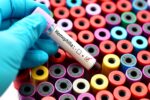Hemlibra’s Benefits for Hem A With Inhibitors Upheld in STASEY Trial

Lana U/Shutterstock
Two years of preventive treatment with Genentech’s Hemlibra (emicizumab) safely and effectively lowered the number of bleeds in people with hemophilia A and clotting factor VIII (FVIII) inhibitors, according to final data from the Phase 3b STASEY trial.
Development of antibodies against the therapy (anti-drug antibodies) was also rare and temporary, and did not affect treatment effectiveness, researchers reported.
These findings, which are consistent with those from previous approval-enabling clinical trials, were presented at the International Society on Thrombosis and Haemostasis 2021 Congress, held virtually July 17–21. The abstract was titled, “Final Analysis of the STASEY Trial: A Single-arm, Multicenter, Open-label, Phase III Clinical Trial Evaluating the Safety and Tolerability of Emicizumab Prophylaxis in Persons with Hemophilia A (PwHA) with Factor (F)VIII Inhibitors.”
“As the treatment landscape evolves, determining the long-term benefit/risk profile of medicines for people living with hemophilia A remains a top priority for the community,” Levi Garraway, MD, PhD, Genentech’s chief medical officer and head of global product development, said in a press release.
“These results provide further confidence in Hemlibra’s favorable safety profile in people with hemophilia A with factor VIII inhibitors, who have historically faced significant treatment challenges,” Garraway added.
FVIII replacement therapy is standard for hemophilia A, and involves supplying patients with FVIII, the blood clotting protein they are missing. However, around a third of patients develop inhibitors, or neutralizing antibodies, against the delivered FVIII, lowering its effectiveness, and in worst cases, rendering it useless.
Administered as an under-the-skin injection, Hemlibra is an antibody that mimics the activity of FVIII by binding to the activated form of factor IX and X, thereby allowing for proper blood coagulation.
It is approved as a routine preventive, or prophylactic, treatment for people with hemophilia A and FVIII inhibitors in more than 100 countries, and for those without inhibitors in more than 80 countries. Approvals for patients regardless of inhibitor status includes the U.S., countries in Europe, and Japan.
The recommended loading dose is 3 mg/kg once every week for the first month, followed by a maintenance dose of either 1.5 mg/kg once every week, 3 mg/kg every two weeks, or 6 mg/kg every four weeks.
Hemlibra’s safety and effectiveness in preventing bleeds in hemophilia A patients with and without inhibitors was established in a clinical program comprising four Phase 3 trials: HAVEN 1 (NCT02622321), HAVEN 2 (NCT02795767), HAVEN 3 (NCT02847637), and HAVEN 4 (NCT03020160).
Results from the HAVEN program showed the therapy effectively lowered the number of bleeds without causing major side effects, including thrombotic events, or those related to blood clots.
The global and open-label Phase 3b STASEY study (NCT03191799) evaluated the longer-term safety, tolerability, and effectiveness of Hemlibra in 195 adults and adolescents, ages 12 and older, with hemophilia A and FVIII inhibitors.
Participants received prophylactic treatment with weekly Hemlibra (loading dose of 3 mg/kg and maintenance dose of 1.5 mg/kg) for up to two years.
It primarily evaluated the therapy’s safety and tolerability profile, while secondary trial goals included assessing changes in several measures of bleed rates and quality of life, as well as treatment preferences, and anti-drug antibody development.
Previous data on 193 patients after nearly one year of treatment in STASEY highlighted a safety, tolerability, and efficacy profile of Hemlibra comparable to that reported in the HAVEN program.
Particularly, no new safety concerns, including blood clot-related complications, were identified, and 85.6% of patients had no bleeds requiring treatment.
Newly presented final results, concerning 193 participants treated for a median of 103.1 weeks (nearly two years), confirmed prior findings.
Hemlibra was generally safe and well-tolerated, with no one experiencing treatment-related serious thrombotic events or thrombotic microangiopathy (damage in small blood vessels due to blood clots).
The most commonly reported adverse events included joint pain (17.1%), common cold (15.5%), headache (15%), injection site reactions (11.4%), and fever (10.9%). Hemlibra-related adverse events were reported in 35 (18.1%) patients, with injection-site reactions being the most common (9.8%).
The therapy also continued to effectively control bleeding episodes, with 82.6% of participants experiencing no bleeds requiring treatment. Annualized bleeding rates were consistent with those previously reported in the HAVEN trials.
Anti-drug antibody development was infrequent and temporary. Antibodies against Hemlibra were detected in 10 (5.2%) patients, and were considered to have neutralizing effects in five (2.6%) of them. These antibodies also disappeared over time, with all STASEY participants testing negative for them at their last visit.
Notably, the presence of anti-drug antibodies did not affect the blood concentration, effectiveness, or safety of the therapy in any of these 10 patients, the researchers reported. None of them experienced a bleed requiring treatment.
These findings confirmed Hemlibra’s favorable safety, tolerability, and efficacy profile, consistent with the Phase 3 HAVEN clinical program.







